The Moto E (2015) Review
by Brandon Chester on April 21, 2015 8:00 AM EST- Posted in
- Smartphones
- Motorola
- Mobile
- Moto E (2015)
CPU Performance
The 2015 Moto E with LTE is the first device with Snapdragon 410 that we've run through our tests. However, buyers of the 3G versions will only get a quad core Snapdragon 200 with 4 Cortex A7 cores. While this is still an improvement over the original, it's quite a disappointment when compared to the LTE edition. To be clear, the results below are from the Snapdragon 410 version, not the Snapdragon 200 version.
Qualcomm's MSM8916 is a quad core Cortex A53 part. Motorola's implementation has it running with a peak CPU core frequency of 1.2GHz, and it's paired with a 400MHz Adreno 306 GPU. Like the Cortex A7 cores used in Snapdragon 410, Cortex A53 is still a dual-issue in-order design, and pipeline depth remains the same as well. ARM has greatly improved branch prediction accuracy and expanded how instructions can be co-issued with Cortex A53, and so much of the performance increase over Cortex A7 will come from those improvements.

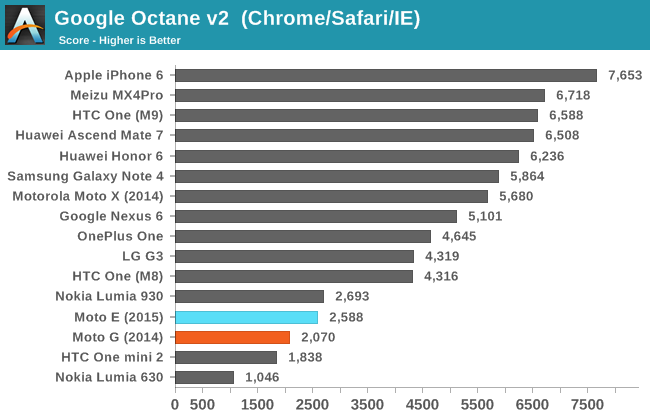
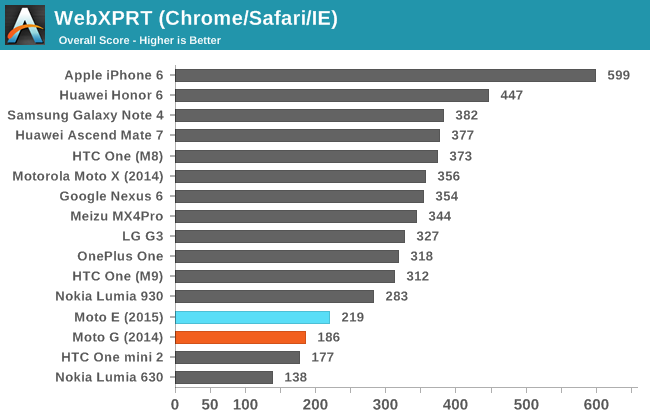
The Moto E shows a decent improvement over Snapdragon 400 based devices like the Moto G, and the improvement over the original Moto E would be even larger. That being said the Moto E doesn't do quite as well as one might expect in our browser tests. Browser optimizations play no small part in this, with Chrome having lagged behind the stock browser from other manufacturers for some time now. Motorola's devices use Chrome as their default browser, and I have a feeling that to an extent the Moto E is limited by software here rather than hardware.
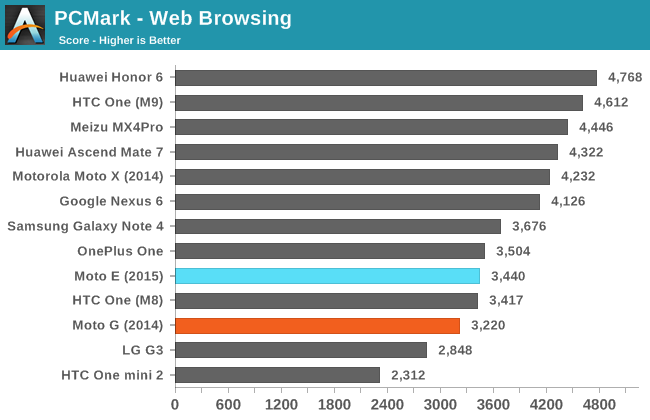

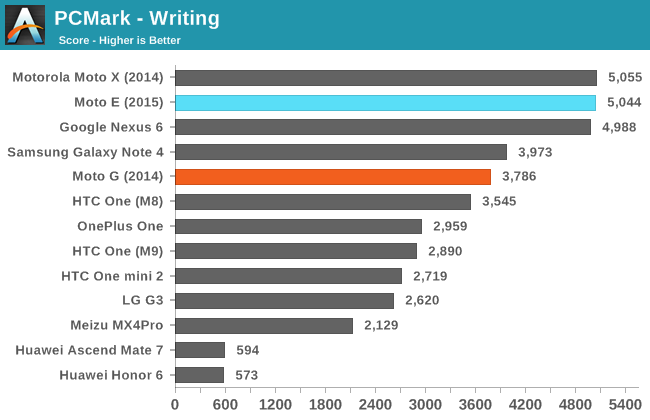
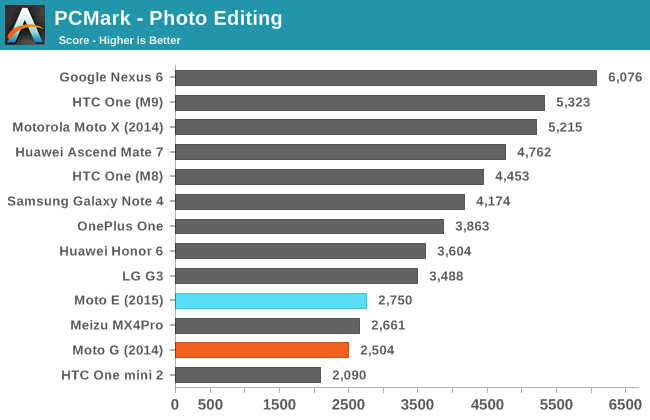
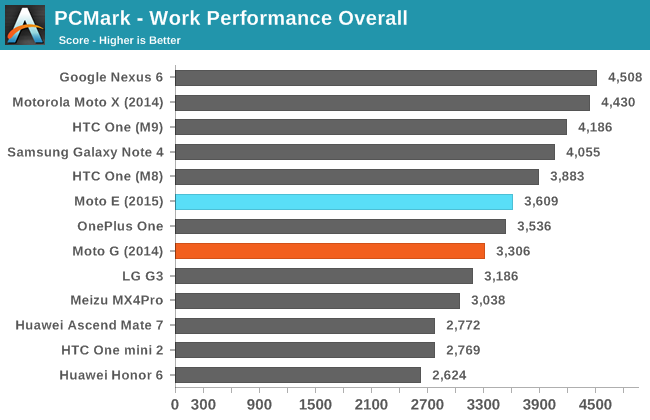
PCMark is a benchmark that focuses more on real-world scenarios where race to sleep speed is paramount. In it we see another modest overall lead compared the Moto G. The writing test in particular shows a great deal of improvement, while the video playback test is slightly worse which I suspect is the result of the Moto E's flash storage speeds causing video seek times to be longer than the Moto G.
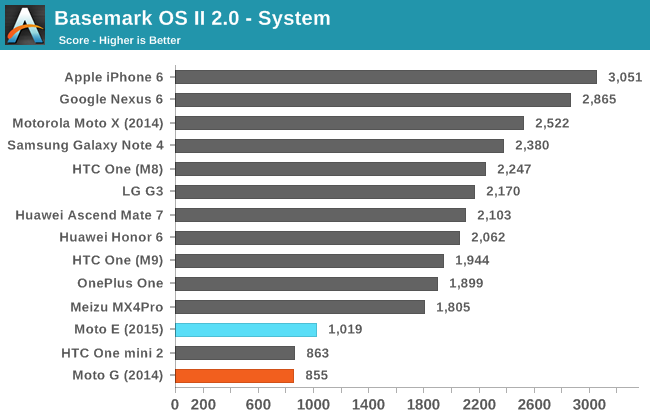
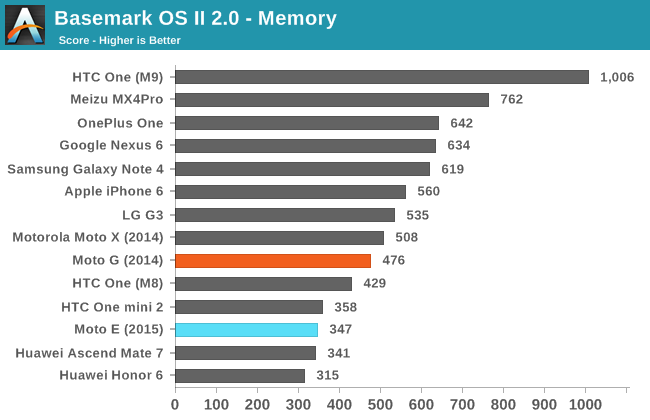
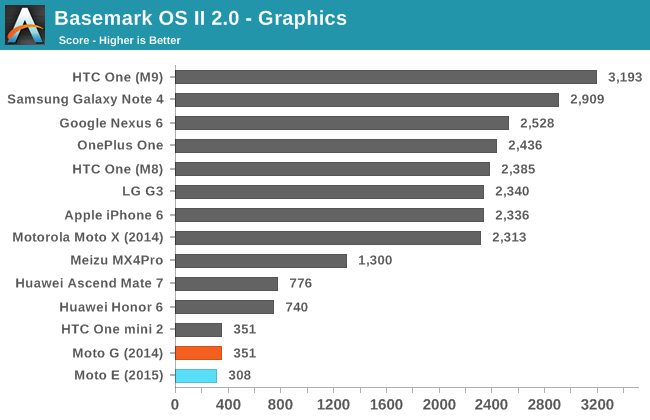
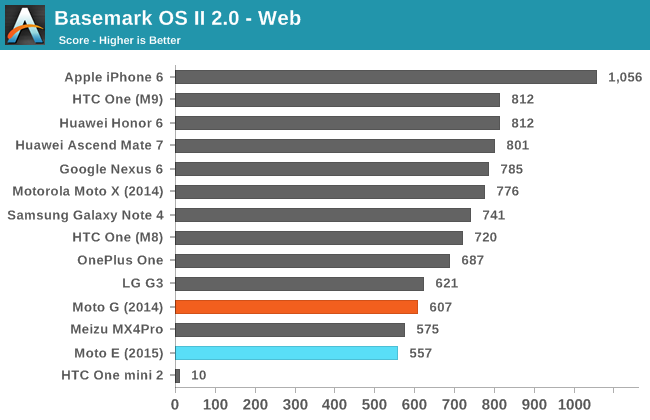
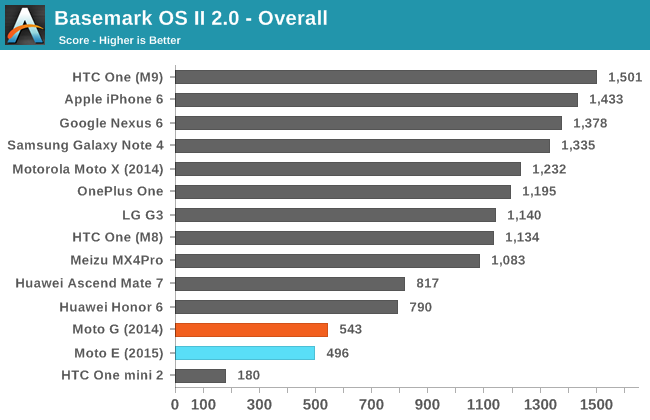
In BaseMark OS II we actually see the Moto E performing worse than the Snapdragon 400 powered Moto G. The Moto G's higher score in the memory subtest helps to give it an advantage overall, and I'm at a loss to explain why the Moto E scores 50 points lower than the Moto G in the Web subtest. I can only imagine that the cause is related to software tuning but I can't definitively say why the gap is as large as it is.
Overall the Moto E does perform well for a budget device, but I do wish Snapdragon 410 showed a greater performance uplift over Snapdragon 400. With only 1GB of RAM and a maximum memory bandwidth of only 5.3GB/s Snapdragon 410 is also under some heavy memory constraints that could be acting as a bottleneck to potentially greater performance improvements with Cortex A53 over Cortex A7.










90 Comments
View All Comments
zepi - Tuesday, April 21, 2015 - link
How much does a 1A or 2A rated charger drop the charging times?I think it is a bit silly to compare chargers instead of phones.
arnoudw - Tuesday, April 21, 2015 - link
Exactly. I reviewed the phone as well (the European version) and the one that's for sale on this side of the ocean hasn't got a charger at all in the box. I just used another charger that I have to charge the phone and charge times were pretty normal: around 2,5 hours from zero to full.AT would maybe consider a disclaimer that chargers can differ per country or region and that can infuence the outcome of this particular test immensely. AT has got a worldwide audience and a lot of the potential buyers of this phone reading the review here might be from another part of the world. That's something for AT to consider, I guess.
TLDR; tested it as well, there was no charger included, charges normally with another charger.
sovking - Tuesday, April 21, 2015 - link
I agree. Charge time comparison should be done with the same charger or better with 2 or 3 chargers.Chargers for smarphone are universal, all devices connect to micro-usb chargers with 5V. At home we have more chargers for more smartphone and we do not matter which charger we are using.
So create a table showing a charging time when using 0.5A, 1A charger, 2A charger.
Some smartphone like Moto G 2014, limit input current, so it worth using until 1.5 A charger, more current is not used.
Ryan Smith - Tuesday, April 21, 2015 - link
To be clear here, the purpose is to test the charge time of the phone in its default configuration. It's not to compare just the chargers, but the entire package.hans_ober - Tuesday, April 21, 2015 - link
You've got a point; anyone who is buying this as their first Android (upgrading from an old Nokia), will most probably use the included charger and it was right to include the charge time using the 'package' the user would most probably use. However, since this is a case where the charger is to blame for the slow charging speeds, it would have been useful to include another result with another high powered charger, which would confirm that the phone IS capable of higher charging speeds if another charger is used and how much time could probably be saved by using a high powered charger.hans_ober - Wednesday, April 29, 2015 - link
Do you have a Quick charge 2.0 charger? The Motorola Turbo Charger? Just curious to see whether it works, because iirc QC 2.0 support was mentioned somewhere.victorson - Tuesday, April 21, 2015 - link
There is a mistake, the Moto E is not $109, it's actually $120 for the slow Snapdragon 200 version, and a not-so-cheap $150 for the Snadpragon 400 version. It's funny how the author can't think of competition when you have devices from Xiaomi and Meizu (among tens if not hundred others) that deliver better value for the money.close - Tuesday, April 21, 2015 - link
In EU the Moto E LTE is ~130E while the cheapest Xiaomi starts at ~170E. I wouldn't think twice.Brandon Chester - Tuesday, April 21, 2015 - link
The number of markets that you can purchase Xiaomi phones in is extremely small, you can count them on one hand. Also I apologize about the pricing error. There have been a few sales on it recently and for whatever reason I noted the price as $109. That being said, it does drop below Motorola's price very often. For example, it's currently available in India on Flipkart for $127 USD. India does happen to be an Xiaomi market and so I would definitely urge buyers there to check out their devices as well. But that's not an option for most buyers.victorson - Tuesday, April 21, 2015 - link
Thanks for the reply, Brandon! I agree that you can get the phone cheaper on sales and I wouldn't argue against the Moto E being an overall good value for the money, but it's also true that you can buy said Xiaomi phones (or many others for that matter, I don't want this to sound like an ad) from retailers like Pandawill.com, Coolicool.com, or others that ship internationally for free. And the user who said that Xiaomi starts at 170 euro, may want to pay a visit and see that prices on those sites start at around $120, not 170 euro.